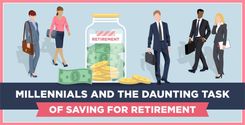Related Posts
Employers and Organizations
The Top 5 Financial Issues Millennials Face Today
Last Update: November 14, 2022
Millennials – this cohort, born between 1981 and 1996, is the first generation to have grown up completely in the digital age, which means they are relatively tech-savvy. They are also the most educated generation in Western history.
Additionally, they have a strong sense of community and focus on society at large over individual needs.
One in three have their own business, while one in five say that business is their main source of income1. Millennials are flexible, pragmatic idealists, frugal, compassionate, progressive, confident, practical, communicative, mobile, and adventurous.
But they are also struggling financially.
When millennials entered the workforce, the Great Recession was at its peak, making finding a job difficult. During their time in the workforce, wages have not kept up with the cost of living. Therefore, millennials often struggle to make ends meet and have trouble meeting traditional milestones like getting married or buying their first home.
Let’s take a look at five financial issues that millennials face today.
1. Student Loan Debt
Millennials have experienced crushing student loan debt. College tuition continued to go up, and with it, so did the number of loans needed to get a degree.
In fact, 14.8 million millennials have student loan debt, which is more than any other generation2. The average balance for a millennial student debt borrower is $38,877.
Because of student loan debt, millennial home ownership has fallen. The average baby boomer bought their first home at 25. For millennials, that number has risen to 35. Not only that, one out of four cannot move from their current residence – whether that is living with parents, renting with a roommate, or needing to expand into a bigger home, due to student loan debt.
2. Price of Real Estate
Census data shows that home prices have increased 118% since 19653. During the same time, wages have increased by just 15%.
This means that for a millennial to afford a home today, they need an income of $144,192, which is double the median household income. If they don’t have this income, then they will have to save for a much longer time to become a homeowner.
First-time homeowners are at an even greater disadvantage. They have not had the ability to take advantage of soaring prices and gain equity, which adds one more stumbling block to building wealth.
3. Cost of Rent
In the past year, the cost of rent rose by 4%4. This is higher than the previous five years with an average increase of 3.3%. However, the increase doesn’t paint an accurate picture.
Once eviction moratoriums were lifted after COVID, rents soared, shooting up 14% in December 2021 compared to one year earlier. At the same time, wages only increased 5.5%5. Rent in 2022 is expected to rise by 10%.
As rents increase at a faster pace than wages, millennials who have yet to purchase a home get further behind. They need more money to purchase a home and have less money available to save due to higher housing prices.
4. Caring for Aging Parents
Millennials are often called the sandwich generation because they end up caring for their children and their aging parents at the same time.
In 1995, just 7% of aging parents lived with their children6. As of 2017, this number had doubled. And this doesn’t take into consideration the millennials who care for parents who still live on their own.
Caring for aging parents leaves less money for millennials to invest. For example, the average cost of $7,000 per year in assistance7, adds up to $70,000 over ten years. If this money had been invested in a retirement fund over 30 years, it would accumulate to more than $500,000.
This is money millennials no longer have for buying a home, paying for college, or retiring.
5. They Need More For Retirement
Finally, inflation is taking a toll on retirement savings. It used to be that $1 million was a good goal. However, in 40 years, that same $1 million will not be enough.
Using an inflation calculator8, to get the same buying power of 2022’s $1 million, a millennial will need $2,373,205 assuming a 2.5% inflation rate. With inflation rates reaching far above that, this number is likely to be much higher.
Unfortunately, millennials are far behind this goal. Three out of five millennials have less than $10,000 saved for retirement9. And the Federal Reserve SCF data10 shows the average retirement for millennials to be:
- Ages 25-29: $9,408.51
- Ages 30-34: $21,731.92
- Ages 35-39: $48,710.27
One of the best ways for millennials to get a handle on their unique financial situations and issues is by engaging in a holistic financial wellness program. Doing so will provide them with the information and tools needed to create strong financial choices and make wise financial decisions.
Download full report from our 12-month Financial Wellness Behavior Change Study
1 - https://startupnation.com/start-your-business/state-entrepreneurship-millennials/
2 - https://educationdata.org/student-loan-debt-by-generation
3 - https://www.realestatewitch.com/house-price-to-income-ratio-2021
4 - https://nypost.com/2022/02/01/us-rent-prices-highest-in-decades-and-theyre-not-coming-down-data-shows/
5 - https://www.naahq.org/news-publications/rent-wages-rise
6 - https://www.bizjournals.com/bizwomen/news/latest-news/2020/05/millennials-step-into-caregiving-roles-for-aging.html?page=all
7 - https://blog.massmutual.com/post/millennialsandwich
8 - https://smartasset.com/investing/inflation-calculator#lkaKzb5yJM
9 - https://www.ramseysolutions.com/retirement/millennials-research#:
10 - https://www.synchronybank.com/blog/median-retirement-savings-by-age/
Featured Posts

Employers and Organizations
3 MIN
10 Simple Ways Benefits Managers Can Recession-Proof Their Employee Benefits Package

Employers and Organizations
3 MIN
3 Reasons to Make After-Tax Contributions to Your Retirement Plan

Employers and Organizations
4 MIN
Financial Information vs Employee Behavior Change: Which Is More Important for Your Company’s Financial Wellness Program?

Employers and Organizations
3 MIN
Does Your Employee Financial Wellness Program Take Mindset Into Consideration?
Related Posts

Enrich News
4 MIN
Millennials and the Daunting Task of Saving For Retirement

Enrich News
3 MIN
How Credit Unions are Engaging Millennials

Financial Institutions
5 MIN
What Financial Institutions Must Do to Stop the Cycle of Life-Long Debt
